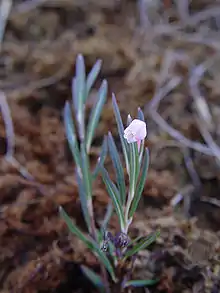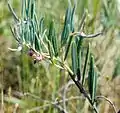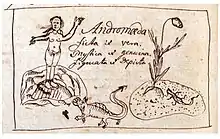Andromeda polifolia
Andromeda polifolia, common name bog-rosemary,[2] is a species of flowering plant in the heath family Ericaceae, native to northern parts of the Northern Hemisphere. It is the only member of the genus Andromeda, and is only found in bogs in cold peat-accumulating areas. Andromeda glaucophylla is a synonym of A. polifolia var. latifolia.[3]
| Andromeda polifolia | |
|---|---|
 | |
| Andromeda polifolia var. polifolia in flower | |
| Scientific classification | |
| Kingdom: | Plantae |
| Clade: | Tracheophytes |
| Clade: | Angiosperms |
| Clade: | Eudicots |
| Clade: | Asterids |
| Order: | Ericales |
| Family: | Ericaceae |
| Subfamily: | Vaccinioideae |
| Tribe: | Andromedeae |
| Genus: | Andromeda L. |
| Species: | A. polifolia |
| Binomial name | |
| Andromeda polifolia | |
Description
It is a small shrub growing to 10–20 cm (4–8 in) (rarely to 40 cm or 16 in) tall with slender stems. The leaves are evergreen, alternately arranged, lanceolate, 1–5 cm (1⁄2–2 in) long and 2–8 mm (0.08–0.31 in) broad, dark green above (purplish in winter) and white beneath with the leaf margins curled under. The flowers are bell-shaped, white to pink, 5–8 mm (0.20–0.31 in) long; flowering is in late spring to early summer. The fruit is a small capsule containing numerous seeds.
There are two varieties, treated as distinct species by some botanists:
- Andromeda polifolia var. polifolia. Northern Europe and Asia, northwestern North America.
- Andromeda polifolia var. latifolia Aiton [1789]. Northeastern North America (syn. A. glaucophylla Link [1821], A. polifolia var. glaucophylla (Link) DC. [1839]).[4]
Etymology
The genus was named by Carl Linnaeus who observed it during his 1732 expedition to Lapland and compared the plant to Andromeda from Greek mythology. The specific epithet is a noun in apposition, which Linnaeus based on Johann Christian Buxbaum's pre-Linnaean generic designation Polifolia.[5] Buxbaum in turn derived the name from Johann Bauhin, who used it to mean "having polium-like leaves". The precise plant that Bauhin meant by polium is uncertain, but it may have been Teucrium montanum.[6] The common name "bog rosemary" derives from the superficial resemblance of the leaves to those of rosemary, which is not closely related.
Fossil record
Many fossil seeds of †Andromeda carpatica have been extracted from borehole samples of the Middle Miocene fresh water deposits in Nowy Sacz Basin, West Carpathians, Poland.[7]
Cultivation
Numerous cultivars have been developed for garden use, all of which require damp acid soil in shade. The cultivars 'Compacta'[8] and 'Macrophylla'[9] have gained the Royal Horticultural Society's Award of Garden Merit. Like most other members of the family Ericaceae, they are acid-loving plants (calcifuges), and must be grown in a medium with a low pH.
Chemistry
Bog rosemary contains grayanotoxin, which when ingested may cause respiratory problems, dizziness, vomiting, or diarrhoea.[10]
Images
 Andromeda polifolia var. polifolia leaves
Andromeda polifolia var. polifolia leaves Andromeda polifolia, Pancake Bay, Ontario
Andromeda polifolia, Pancake Bay, Ontario Illustration
Illustration Linnaeus' original drawing
Linnaeus' original drawing
References
- Maiz-Tome, L. (2016). "Andromeda polifolia". The IUCN Red List of Threatened Species. IUCN. 208. e.T64263821A67728518. doi:10.2305/IUCN.UK.2016-1.RLTS.T64263821A67728518.en.
- BSBI List 2007 (xls). Botanical Society of Britain and Ireland. Archived from the original (xls) on 2015-06-26. Retrieved 2014-10-17.
- "Andromeda polifolia L." Plants of the World Online. Royal Botanic Gardens, Kew. Retrieved 2023-04-22.
- "Andromeda polifolia L. var. latifolia Aiton". Germplasm Resources Information Network. Agricultural Research Service, United States Department of Agriculture.
- Turland, N.J.; et al., eds. (2018). "Art. 60.10". International Code of Nomenclature for algae, fungi, and plants (Shenzhen Code) adopted by the Nineteenth International Botanical Congress Shenzhen, China, July 2017 (electronic ed.). Glashütten: International Association for Plant Taxonomy. Retrieved 2019-03-07..
- Nelson, E. Charles; Oswald, P.H. (2005). "Polifolia revisited and explained" (PDF). Huntia: A Journal of Botanical History. 12 (1): 5–11.
- Macroscopic plant remains from the freshwater Miocene of the Nowy Sącz Basin (West Carpathians, Poland) by Łańcucka-Środoniowa M, Acta Palaeobotanica 1979 20 (1): 3-117.
- "RHS Plant Selector - Andromeda polifolia 'Compacta'". Retrieved 23 February 2020.
- "RHS Plant Selector - Andromeda polifolia 'Macrophylla'". Retrieved 23 February 2020.
- Paul Alaback; Joe Antos; Trevor Goward; Ken Lertzman; Andy MacKinnon; Jim Pojar; Rosamund Pojar; Andrew Reed; Nancy Turner; Dale Vitt (2004). Jim Pojar; Andy MacKinnon (eds.). Plants of the Pacific Northwest Coast (Revised ed.). Vancouver: Lone Pine Publishing. p. 53. ISBN 978-1-55105-530-5.
External links
- Images at Flavon's art gallery: Flower + Fruits, Seeds
